
Tracking Hub Administrator Guide
Version 1.4 | Published October 30, 2020 ©
Router Control
Camera cuts can be controlled from within the Studio Manager by using the Router Control, accessible from the Tools menu. The Router Control can control camera cuts by using presets, or manually. By adding presets for the most commonly used inputs and outputs, this interface allows for quick and easy camera cuts on demand. When Router Control is in use, an additional configuration file is used. This file is located in %ProgramData%\vizrt\VizTH\Cfg\<Studio config name>, and the file is named XML_TH_RouterCfg.xml. At any given time, configured connection or preset parameters can be deleted independently from the overall router control configuration by clicking the corresponding trash can icon.
To Add a Router Control Preset
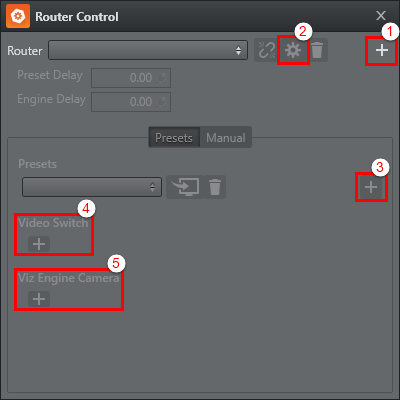
-
Open the Tools menu and select Router Control.
-
In the dialogue window that opens, select a Model and enter a Name for the router, then click Add. The selected model defines the communication protocol which is used, and is not vendor dependent. The available protocols are:
-
Black Magic (serial)
-
Nevion MRP (network)
-
Nevion NCB (serial)
-
-
Click the plus icon (+) in the upper right corner to add a router (1). If a router has been added to the system previously, it can be reused by selecting it from the Router drop-down list.
-
Click the cogwheel icon to configure the connection settings and AB mode for the router (2).
-

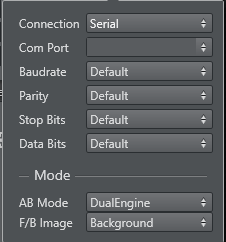
-
Connection: Select the connection protocol. Available options are Serial, UDP and TCP. For serial connections, the Com Port needs to be set in all cases. The other parameters may be left to their default settings, or specified based on the requirements of the specific hardware connected. Please refer to the vendor documentation for connection details.
-
AB Mode: AB mode is used to deal with situations with unreliable router switching times. When running in AB mode, two SDI cables are connected from the router to the Viz Engine inputs. Upon switching, the router first switches the signal to the unused line. If the signal is valid, the command to switch the input and camera is sent to the Engine. This way, the output from Viz Engine is not interrupted even if the router switching has a slight delay. This mode can be used, when the video is whether linear keyed from the background or chroma keyed with one of the internal chroma keyers of Viz.
-
Dual Engine: Dual Engine mode is used, when ONE and only ONE physical Engine machine should handle multiple cameras with a switcher.
In the last few years, it became more difficult to find cheap routers which are able to switch with predictable timing. The method described here makes it possible to use the already implemented A/B mode in Tracking Hub with an external keyer, like the Ultimatte 12. The goal is to create a low cost virtual set with an arbitrary number of cameras with a one machine solution.
On this machine (preferably a Z8 with an x.mio3 and two graphics adapters) a dual Engine is installed with a Tracking Hub.
Let also assume, that a BlackMagic Video Hub (or any other cheap router) and an Ultimatte 12 are present.
In this scenario, the Video Hub is connected via Ethernet to the VSS machine. In Tracking Hub, a new switching method is added to the existing A/B mode. In this mode, the user can enter the IP and port of the first and second instance of the Engines. The router is managed by the selected protocol driver.
When selecting this mode, the following steps occur:
Tracking Hub takes over instance two and generates a basic scene with two inputs by using the command interface. Using this method ensures that instance two, which is responsible for the synchronized switching, is in place and ready. Tracking Hub also checks if the instance is present and On Air, that all inputs are enabled and that the sync source is set and the instance is locked.
Tracking Hub contacts the video hub and make sure that it is reacting.
Then the user is able to enter any amount of presets in the matrix controls of Tracking Hub. Switching can, like before, happen by GPI, commands or any future interface.
In case of switching the following occurs:
Status: Tracking Hub knows the actual status of the active output of instance two. There is always an active and inactive input present on instance two.
When a new camera is activated by a preset, Tracking Hub commands the router to switch this video feed to the inactive input of instance two. After that Tracking Hub waits a defined (by user) timespan, until the signal is stable switched and valid on the Matrox input. If necessary, Tracking Hub can check if everything is OK at the Engine by command interface, and no error messages are coming in.
After that period, Tracking Hub triggers a synchronized command to instance one and instance two (with the necessary delays) to switch camera on one and video on instance two.
This workflow can then be repeated an unlimited number of times.
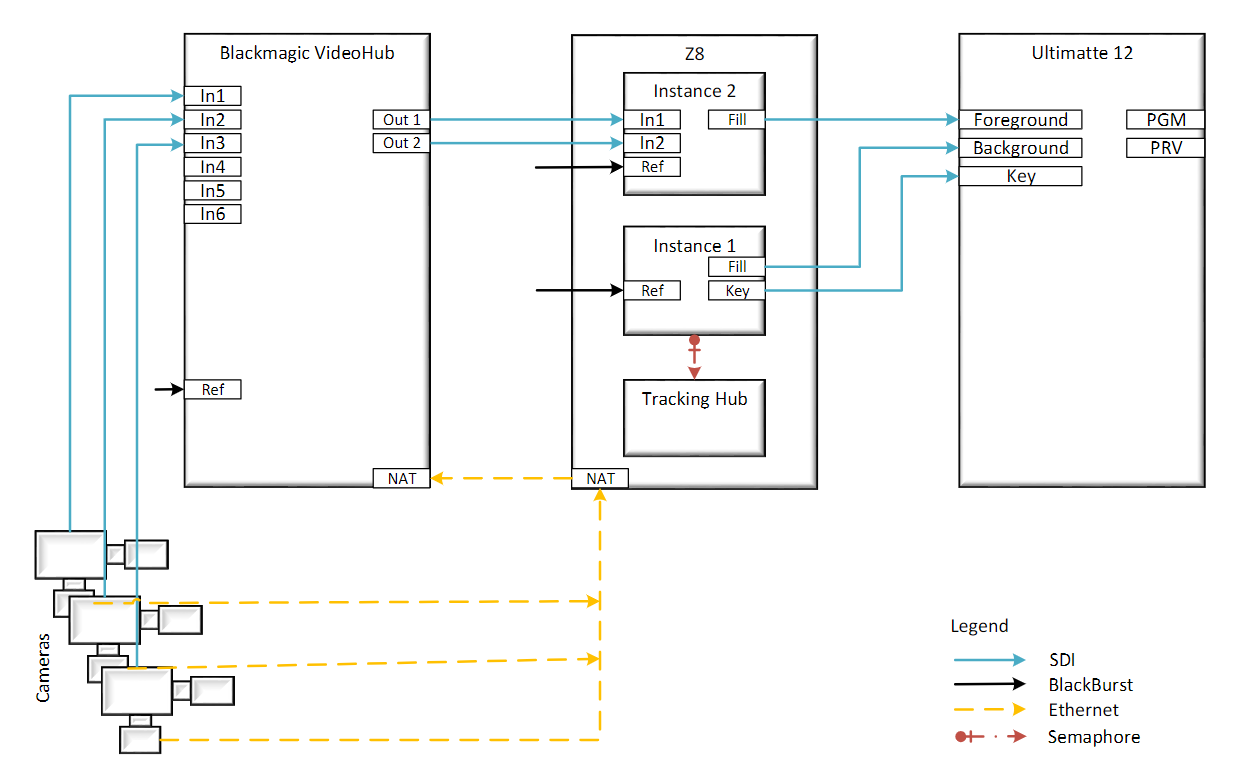
-
-
If required, a delay can be added in the Preset Delay or Engine Delay fields.
-
Next, click the plus icon (+) to the right in the Preset section to add a preset (3). Enter a Name and click Add.
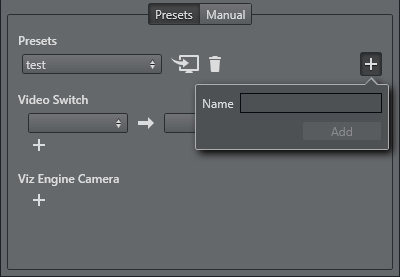
-
In the Video Switch section, select the Input and Output on the router from the left and right drop-down lists, respectively.
-
In the Viz Engine Camera section, select which Engine and camera to switch to.
A router connection with a preset has now been configured, and the Router Control window should look like this:
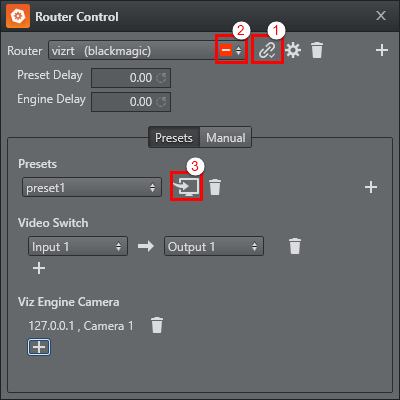
Click the Connect button (1) to connect to the configured router. If there is a connection problem, this is indicated by a red warning box in the Router drop-down list (2). To issue the take command to the router and Engine, click the Take button (3).
When using DualEngine mode:
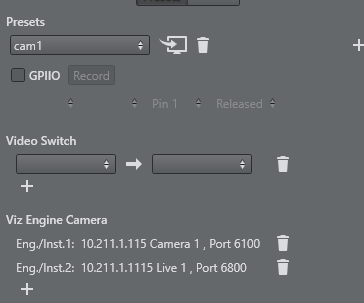
The first Engine is the Renderer, and the Engine camera is switched on this instance. The second Engine is the Video instance, and the video is switched on that. In the picture above you can see, that Engine one is Titled as Camera Nr. while Engine two is marked as Live Nr.. In Dual Engine mode, it only makes sense to configure two Engines. Please note that in the Engine instance settings, the field Port has been added!
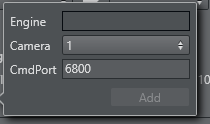
By default the port for instance one is: 6100 and the port for instance two is: 6800. But this settings can differ from installation to installation. Please check the Engine configuration for the correct port settings.
GPI IO Device Switching
In addition to the standard configuration, you can add a GPI IO device for switching (4). You can select this device if it was detected during startup. This detection is done automatically.
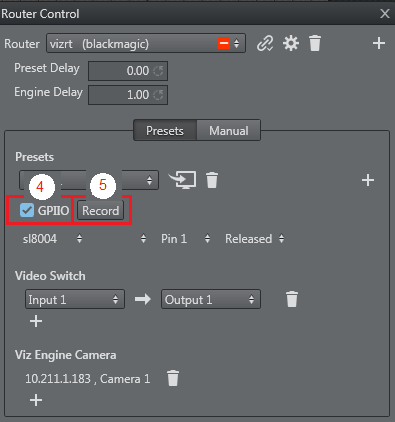
To configure the device, you have two options:
-
Manual: Select the device, the port (not available for all devices), and the pin. In addition, you can select if the switching should react on pressing or releasing the button.
-
Automatic: Click Record (5) and then select the button on the GPI IO device. The button is recorded and connected to the actual preset.